Boeing 737

Boeing 737

| Boeing 737 | |
|---|---|
| A Boeing 737-200, the first mass-produced 737 model, in operation with South African Airways in 2007 | |
| Role | Narrow-body aircraft |
| National origin | United States |
| Manufacturer | Boeing Commercial Airplanes |
| First flight | April 9, 1967 |
| Introduction | February 10, 1968, with Lufthansa |
| Status | In service |
| Primary users | Southwest Airlines Ryanair United Airlines American Airlines |
| Produced | 1966–present |
| Number built | 10,559 as of July 2019[4] |
| Unit cost | |
| Variants | Boeing T-43 |
| Developed into | Boeing 737 Classic Boeing 737 Next Generation Boeing 737 MAX |
The Boeing 737 is an American short- to medium-range twinjet narrow-body airliner developed and manufactured by Boeing Commercial Airplanes. Originally developed as a shorter, lower-cost twin-engine airliner derived from the 707 and 727, the 737 has developed into a family of several passenger models with capacities from 85 to 215 passengers. The 737 is Boeing's only narrow-body airliner in production, with the 737 Next Generation (-700, -800, and -900ER), and the re-engined and updated 737 MAX variants.
The 737 was originally envisioned in 1964. The initial 737-100 made its first flight in April 1967, and entered airline service in February 1968 with Lufthansa.[7][8] Next, the lengthened 737-200 entered service in April 1968. In the 1980s Boeing launched the longer 737-300, -400, and -500 variants (referred to as the Boeing 737 Classic series) featuring CFM56 turbofan engines and wing improvements.
The Boeing 737 Next Generation (NG) was introduced in the 1990s, with a redesigned, increased wing span, upgraded "glass" cockpit, and new interior. The 737 NG comprises the 737-600, -700, -800, and -900 variants, with lengths ranging from 31.09 to 42.06 m (102 to 138 ft). Boeing Business Jet versions of the 737 NG are also produced. The 737 was revised again in the 2010s for greater efficiency, with the 737 MAX series featuring CFM LEAP-1B engines and improved winglets. The 737 MAX entered service in 2017, but in March 2019, was grounded worldwide following two fatal crashes.
The 737 series is the highest-selling commercial jetliner in history.[7] The 737 has been continuously manufactured since 1967; the 10,000th was rolled out on March 13, 2018, a MAX 8 destined for Southwest Airlines, and over 4,600 orders are pending.[9] Assembly of the 737 is performed at the Boeing Renton Factory in Renton, Washington. Many 737s serve markets previously filled by 707, 727, 757, DC-9, and MD-80/MD-90 airliners, and the aircraft currently competes primarily with the Airbus A320 family.[10] As of 2006, there were an average of 1,250 Boeing 737s airborne at any given time, with two either departing or landing somewhere every five seconds.[11]
| Boeing 737 | |
|---|---|
| A Boeing 737-200, the first mass-produced 737 model, in operation with South African Airways in 2007 | |
| Role | Narrow-body aircraft |
| National origin | United States |
| Manufacturer | Boeing Commercial Airplanes |
| First flight | April 9, 1967 |
| Introduction | February 10, 1968, with Lufthansa |
| Status | In service |
| Primary users | Southwest Airlines Ryanair United Airlines American Airlines |
| Produced | 1966–present |
| Number built | 10,559 as of July 2019[4] |
| Unit cost | |
| Variants | Boeing T-43 |
| Developed into | Boeing 737 Classic Boeing 737 Next Generation Boeing 737 MAX |
Development
Background
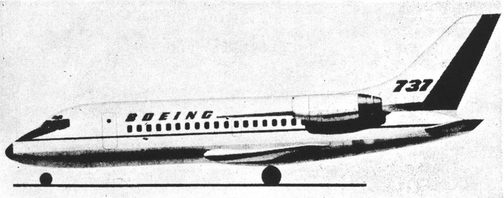
1964 concept with tail mounted engines
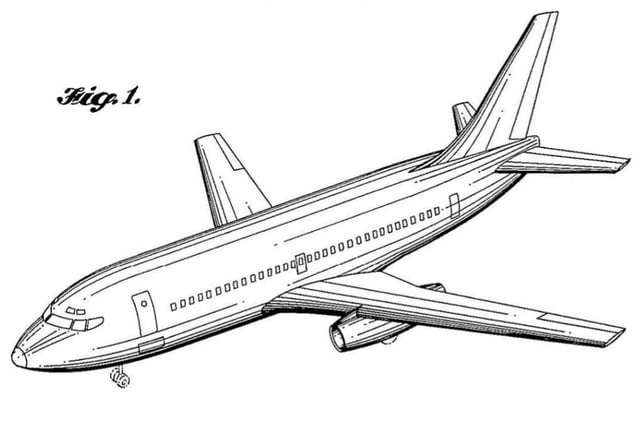
Oct 18, 1966 Jet aircraft patent, filed June 22, 1965 by John Steiner and Joe Sutter for Boeing
Boeing had been studying short-haul jet aircraft designs, and wanted to produce another aircraft to supplement the 727 on short and thin routes.[12] Preliminary design work began on May 11, 1964,[13] and Boeing's intense market research yielded plans for a 50- to 60-passenger airliner for routes 50 to 1,000 mi (100 to 1,600 km) long.[12][14]
Initial design featured podded engines on the aft fuselage and a T-tail like the 727, and five-abreast seating, but engineer Joe Sutter instead placed the engines under the wings to lighten the structure, enabling fuselage widening for six-abreast seating.[15] The 737 design was presented in October 1964 at the Air Transport Association maintenance and engineering conference by chief project engineer Jack Steiner, where its elaborate high-lift devices raised concerns about maintenance costs and dispatch reliability.[15] The launch decision for the $150 million development was made by the board on February 1, 1965.[15]
Lufthansa became the launch customer on February 19, 1965,[16] with an order for 21 aircraft, worth $67 million[17] in 1965, after the airline received assurances from Boeing that the 737 project would not be canceled.[18] Consultation with Lufthansa over the previous winter resulted in an increase in capacity to 100 seats.[16]
On April 5, 1965, Boeing announced an order by United Airlines for 40 737s. United wanted a slightly larger airplane than the original 737, so Boeing stretched the fuselage 36 in (91 cm) ahead of, and 40 in (102 cm) behind the wing.[19] The longer version was designated 737-200, with the original short-body aircraft becoming the 737-100.[20]
Detailed design work continued on both variants at the same time. Boeing was far behind its competitors when the 737 was launched; rival aircraft BAC-111, Douglas DC-9, and Fokker F28 were already into flight certification.[17] To expedite development, Boeing used 60% of the structure and systems of the existing 727, the most notable being the fuselage cross-section. This fuselage permitted six-abreast seating compared to the rival BAC-111 and DC-9's five-abreast layout.[16]
Design engineers decided to mount the nacelles directly to the underside of the wings to reduce the landing gear length and kept the engines low to the ground for easy ramp inspection and servicing.[21] Many thickness variations for the engine attachment strut were tested in the wind tunnel and the most desirable shape for high speed was found to be one which was relatively thick, filling the narrow channels formed between the wing and the top of the nacelle, particularly on the outboard side.
Originally, the span arrangement of the airfoil sections of the 737 wing was planned to be very similar to that of the 707 and 727, but somewhat thicker. A substantial improvement in drag at high Mach numbers was achieved by altering these sections near the nacelle.[22] The engine chosen was the Pratt & Whitney JT8D-1 low-bypass ratio turbofan engine, delivering 14,500 lbf (64 kN) thrust.[23] With the wing-mounted engines, Boeing decided to mount the horizontal stabilizer on the fuselage rather than the T-tail style of the Boeing 727.[19]
Production and testing

The Boeing 737 first flight, a -100, on April 9, 1967
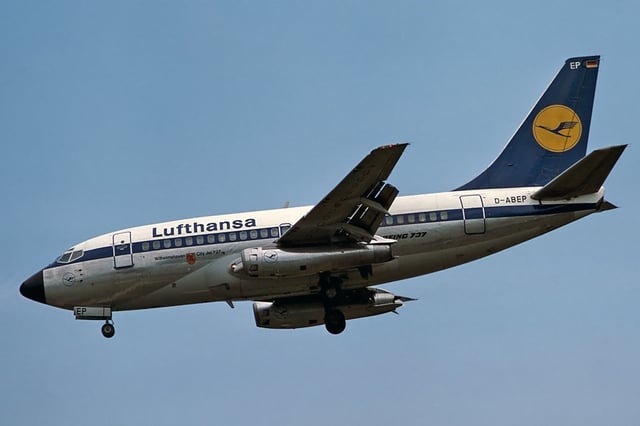
Lufthansa received the first 737-100 on December 28, 1967
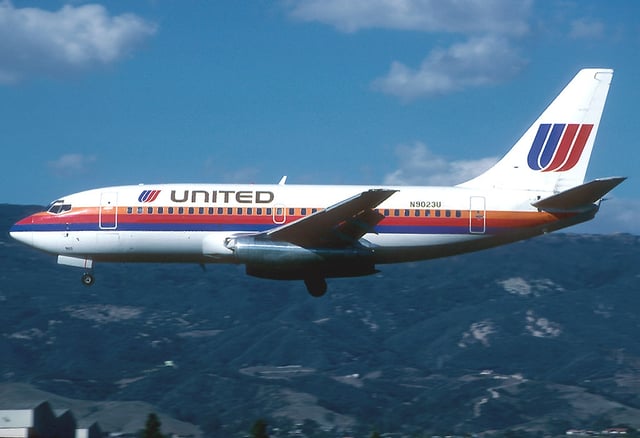
United Airlines introduced the 737-200 on April 28, 1968
The initial assembly of the Boeing 737 was adjacent to Boeing Field (now officially named King County International Airport) because the factory in Renton was filled to capacity with the production of the 707 and 727. After 271 of the Boeing 737 aircraft were built, production was moved to Renton in late 1970.[18][24] A significant portion of fuselage assembly—previously done by Boeing in Wichita, Kansas—is now performed by Spirit AeroSystems, which purchased some of Boeing's assets in Wichita.[25][26] Key to increasing production efficiencies, the entire fuselage is shipped since the 737 Next Generation while it was sent in two pieces before.[27]
The fuselage is joined with the wings and landing gear and then moves down the assembly line for the engines, avionics, and interiors. After rolling out the aircraft, Boeing tests the systems and engines before a plane's maiden flight to Boeing Field, where it is painted and fine-tuned before delivery to the customer.[28] The first of six -100 prototypes rolled out in December 1966 and made its maiden flight on April 9, 1967, piloted by Brien Wygle and Lew Wallick.[29]
On December 15, 1967, the Federal Aviation Administration certified the 737-100 for commercial flight,[30] issuing Type Certificate A16WE.[31] The 737 was the first aircraft to have, as part of its initial certification, approval for Category II approaches,[32] which refers to an precision instrument approach and landing with a decision height between 98 to 197 feet (30 to 60 m).[33]
Sales were low in the early 1970s and, after a peak of 114 deliveries in 1969, only 22 737s were shipped in 1972 with 19 in backlog. The US Air Force saved the program by ordering T-43s. African airline orders kept the production running until the 1978 US Airline Deregulation Act where demand was better for a six-abreast narrow-body aircraft, particularly re-engined with the CFM56, struggling at the time.[15]
Initial derivatives

737-200 advanced planform, showing the thrust reverser extension
The original engine nacelles incorporated thrust reversers taken from the 727 outboard nacelles. They proved to be relatively ineffective and tended to lift the aircraft up off the runway when deployed. This reduced the downforce on the main wheels thereby reducing the effectiveness of the wheel brakes. In 1968, an improvement to the thrust reversal system was introduced.[37] A 48-inch tailpipe extension was added and new, target-style, thrust reversers were incorporated. The thrust reverser doors were set 35 degrees away from the vertical to allow the exhaust to be deflected inboard and over the wings and outboard and under the wings.[38] The improvement became standard on all aircraft after March 1969, and a retrofit was provided for active aircraft. Boeing fixed the drag issue by introducing new longer nacelle/wing fairings, and improved the airflow over the flaps and slats. The production line also introduced an improvement to the flap system, allowing increased use during takeoff and landing. All these changes gave the aircraft a boost to payload and range, and improved short-field performance.[30] In May 1971, after aircraft #135, all improvements, including more powerful engines and a greater fuel capacity, were incorporated into the 737-200, giving it a 15% increase in payload and range over the original -200s.[32] This became known as the 737-200 Advanced, which became the production standard in June 1971.[39]
In 1970, Boeing received only 37 orders. Facing financial difficulties, Boeing considered closing the 737 production-line and selling the design to Japanese aviation companies.[18] After the cancellation of the Boeing Supersonic Transport, and scaling back of 747 production, enough funds were freed up to continue the project.[40] In a bid to increase sales by offering a variety of options, Boeing offered a 737C (Convertible) model in both -100 and -200 lengths. This model featured a 134 in × 87 in (340 cm × 221 cm) freight door just behind the cockpit, and a strengthened floor with rollers, which allowed for palletized cargo. A 737QC (Quick Change) version with palletized seating allowed for faster configuration changes between cargo and passenger flights.[41] With the improved short-field capabilities of the 737, Boeing offered the option on the -200 of the gravel kit, which enables this aircraft to operate on remote, unpaved runways.[42][43] Until retiring its -200 fleet in 2007, Alaska Airlines used this option for some of its combi aircraft rural operations in Alaska.[44] Northern Canadian operators Air Inuit, Air North, Canadian North, First Air and Nolinor Aviation still operate the gravel kit aircraft in Northern Canada, where gravel runways are common.
737 Classic
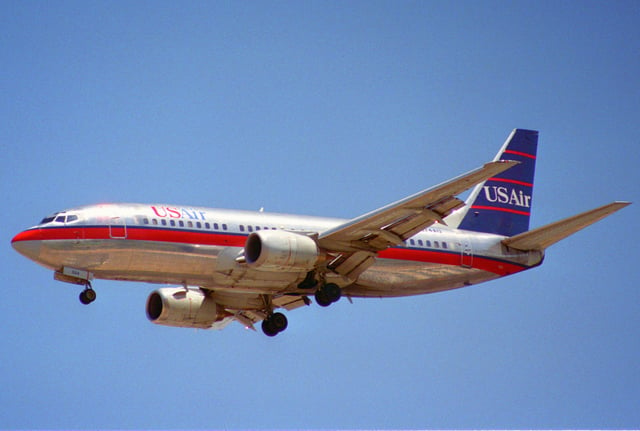
USAir received the first 737 Classic with wider CFM56 turbofans on November 28, 1984

Transaero 737-400 at takeoff. The stubbier CFM56 engines are mounted ahead of the wings.
Development began in 1979 for the 737's first major revision. Boeing wanted to increase capacity and range, incorporating improvements to upgrade the aircraft to modern specifications, while also retaining commonality with previous 737 variants. In 1980, preliminary aircraft specifications of the variant, dubbed 737-300, were released at the Farnborough Airshow.[47]
Boeing engineer Mark Gregoire led a design team, which cooperated with CFM International to select, modify and deploy a new engine and nacelle that would make the 737-300 into a viable aircraft. They chose the CFM56-3B-1 high-bypass turbofan engine to power the aircraft, which yielded significant gains in fuel economy and a reduction in noise, but also posed an engineering challenge, given the low ground clearance of the 737 and the larger diameter of the engine over the original Pratt & Whitney engines. Gregoire's team and CFM solved the problem by reducing the size of the fan (which made the engine slightly less efficient than it had been forecast to be), placing the engine ahead of the wing, and by moving engine accessories to the sides of the engine pod, giving the engine a distinctive non-circular "hamster pouch"[48] air intake.[49][50] Earlier customers for the CFM56 included the U.S. Air Force with its program to re-engine KC-135 tankers.[51]
The passenger capacity of the aircraft was increased to 149 by extending the fuselage around the wing by 9 feet 5 inches (2.87 m). The wing incorporated several changes for improved aerodynamics. The wingtip was extended 9 in (23 cm), and the wingspan by 1 ft 9 in (53 cm). The leading-edge slats and trailing-edge flaps were adjusted.[49] The tailfin was redesigned, the flight deck was improved with the optional EFIS (Electronic Flight Instrumentation System), and the passenger cabin incorporated improvements similar to those developed on the Boeing 757.[52] The prototype −300, the 1,001st 737 built, first flew on February 24, 1984 with pilot Jim McRoberts.[52] It and two production aircraft flew a nine-month-long certification program.[53]
In June 1986, Boeing announced the development of the 737-400,[54] which stretched the fuselage a further 10 ft (3.0 m), increasing the passenger load to 188.[55] The -400s first flight was on February 19, 1988, and, after a seven-month/500-hour flight-testing run, entered service with Piedmont Airlines that October.[56]
The -500 series was offered, due to customer demand, as a modern and direct replacement of the 737-200. It incorporated the improvements of the 737 Classic series, allowing longer routes with fewer passengers to be more economical than with the 737-300. The fuselage length of the -500 is 1 ft 7 in (48 cm) longer than the 737-200, accommodating up to 140[55] passengers. Both glass and older-style mechanical cockpits arrangements were available.[56] Using the CFM56-3 engine also gave a 25% increase in fuel efficiency over the older -200s P&W engines.[56]
After the introduction of the −600/700/800/900 series, the −300/400/500 series was called the 737 Classic series.[59]
The price of jet fuel reached a peak in 2008, when airlines devoted 40% of the retail price of an air ticket to pay for fuel, versus 15% in 2000.[60][61] Consequently, in that year carriers retired Classic 737 series aircraft to reduce fuel consumption; replacements consisted of more efficient Next Generation 737s or Airbus A320/A319/A318 series aircraft. On June 4, 2008, United Airlines announced it would retire all 94 of its Classic 737 aircraft (64 737-300 and 30 737-500 aircraft), replacing them with Airbus A320 jets taken from its Ted subsidiary, which has been shut down.[62][63][64]
737 Next Generation
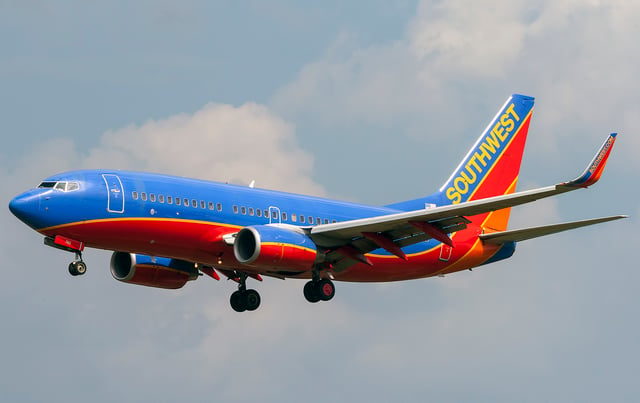
Southwest Airlines took delivery of the first 737 Next Generation in December 1997
The Boeing 737 Next Generation was launched in 1993 as the third generation derivative of the Boeing 737, it is produced since 1996 and is an upgrade of the 737 Classic (−300/-400/-500) series.
It features a redesigned wing with a larger area, a wider wingspan, a greater fuel capacity and higher MTOWs. It is equipped with CFM56-7 series engines, a glass cockpit, and features upgraded and redesigned interior configurations. It has a longer range and larger variants than its predecessor: the series includes four models, the −600/-700/-800/-900, seating between 108 and 215 passengers. The 737NG's primary competition is with the Airbus A320 family.
As of May 2019, a total of 7,097 737NG aircraft have been ordered, of which 7,031 have been delivered, the remaining orders are in the -700 BBJ, -800, -800 BBJ and -900ER variants.[4] The upgraded and re-engined 737 MAX series is to supplant the 737NG, with the first 737 MAX delivered in 2017.
737 replacement or re-engining
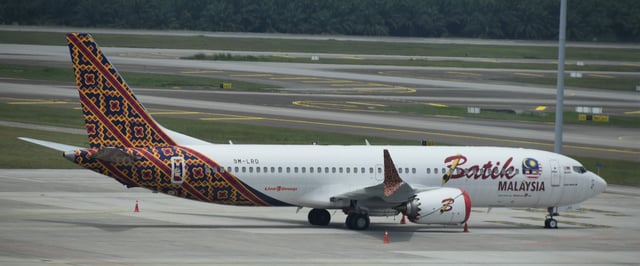
The 737 MAX entered service with Lion Air's subsidiary Malindo Air (wearing Batik Air Malaysia livery) on May 22, 2017
Since 2006, Boeing has discussed replacing the 737 with a "clean sheet" design (internally named "Boeing Y1") that could follow the Boeing 787 Dreamliner.[65] A decision on this replacement was postponed, and delayed into 2011.[66] In November 2014, it was reported that Boeing plans to develop a new aircraft to replace the 737 in the 2030 time frame. The airplane is to have a similar fuselage, but probably made from composite materials similar to the Boeing 787 Dreamliner.[67] Boeing also considers a parallel development along with the 757 replacement, similar to the development of the 757 and 767 in the 1970s.[68]
On July 20, 2011, Boeing announced plans for a new 737 series to be powered by the CFM International LEAP-X engine, with American Airlines intending to order 100 of these aircraft.[69] On August 30, 2011, Boeing confirmed the launch of the 737 new engine variant, called the 737 MAX,[70] with new CFM International LEAP-1B engines.[71][72][73]
On September 23, 2015, Boeing announced a collaboration with Commercial Aircraft Corporation of China Ltd. to build a completion and delivery facility for the 737 in China, the first outside the U.S.[74][75] This facility initially handles interior finishing only, but will subsequently be expanded to include paintwork. The first 737 MAX was delivered from the facility to Air China on December 15, 2018.[76]
Design
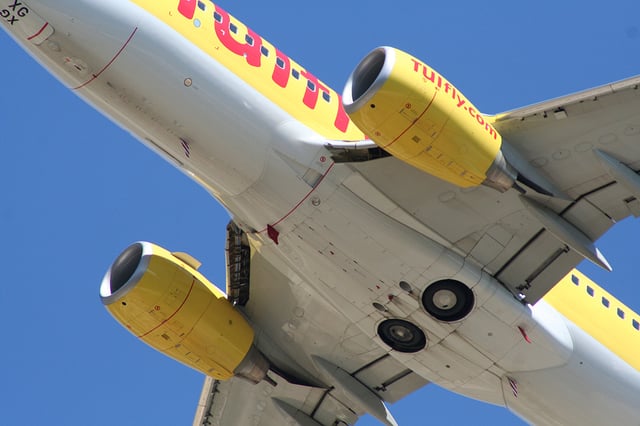
Boeing 737-700 showing the retracted landing gear and engine nacelles with flattened underside and triangular shape
The 737's main landing gear, under the wings at mid-cabin, rotates into wheel wells in the aircraft's belly. The legs are covered by partial doors, and "brush-like" seals aerodynamically smooth (or "fair") the wheels in the wells. The sides of the tires are exposed to the air in flight. "Hub caps" complete the aerodynamic profile of the wheels. It is forbidden to operate without the caps, because they are linked to the ground speed sensor that interfaces with the anti-skid brake system. The dark circles of the tires are clearly visible when a 737 takes off, or is at low altitude.[77]
As the 737's fuselage design is derived from that of the Boeing 707, it inherited the distinctive 'eyebrow windows' used on the larger airliner, situated just above the windscreen.
737s are not equipped with fuel dump systems. The original aircraft were too small to require them, and adding a fuel dump system to the later, larger variants would have incurred a large weight penalty. Boeing instead demonstrated an "equivalent level of safety". Depending upon the nature of the emergency, 737s either circle to burn off fuel or land overweight. If the latter is the case, the aircraft is inspected by maintenance personnel for damage and then returned to service if none is found.[78][79]
Engines
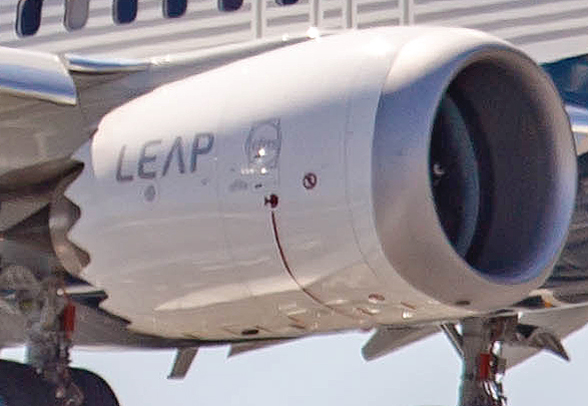
737 MAX 9 CFM LEAP-1B engine with 787-derived engine chevrons
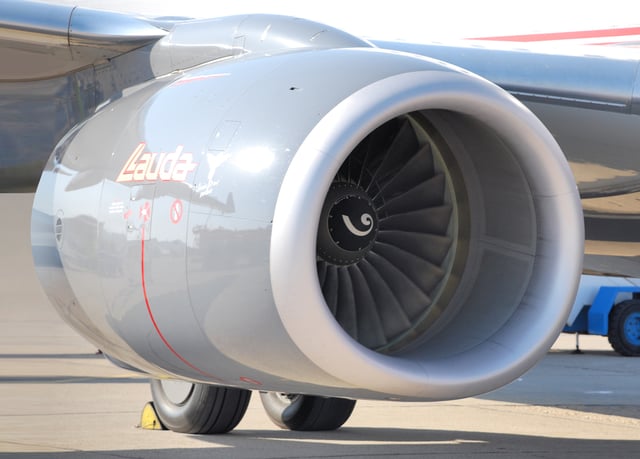
737-800 CFM56 engine with ovoid "hamster pouch"[48] inlet
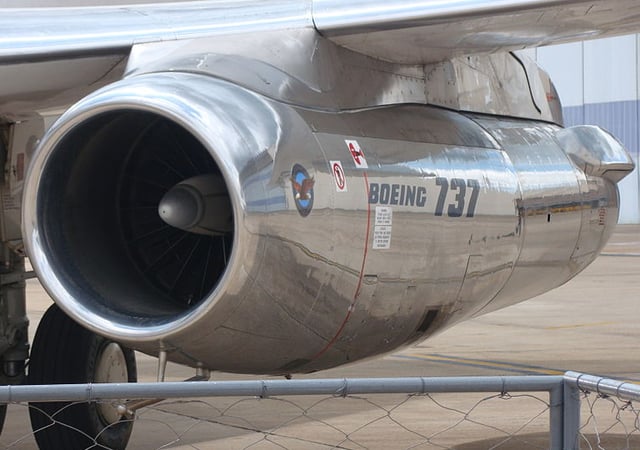
737-200 JT8D engine with original cowling design
Engines on the 737 Classic series (−300, −400, −500) and Next-Generation series (−600, −700, −800, −900) do not have circular inlets like most aircraft. The 737 Classic series featured CFM56 turbofan engines, which yielded significant gains in fuel economy and a reduction in noise over the JT8D engines used on the −100 and −200, but also posed an engineering challenge given the low ground clearance of the 737. Boeing and engine supplier CFMI solved the problem by placing the engine ahead of (rather than below) the wing, and by moving engine accessories to the sides (rather than the bottom) of the engine pod, giving the 737 a distinctive non-circular air intake.[49]
The wing also incorporated changes for improved aerodynamics. The engines' accessory gearbox was moved from the 6 o'clock position under the engine to the 4 o'clock position (from a front/forward looking aft perspective). This side-mounted gearbox gives the engine a somewhat triangular rounded shape. Because the engine is close to the ground, 737-300s and later models are more prone to engine foreign object damage (FOD). The improved CFM56-7 turbofan engine on the 737 Next Generation is 7% more fuel-efficient than the previous CFM56-3 in the 737 classics. The newest 737 variants, the 737 MAX family, feature CFM International LEAP-1B engines with a 68 inches (1.73 m) fan diameter. These engines were expected to be 10-12% more efficient than the CFM56-7B engines on the 737 Next Generation family.[80]
Flight systems
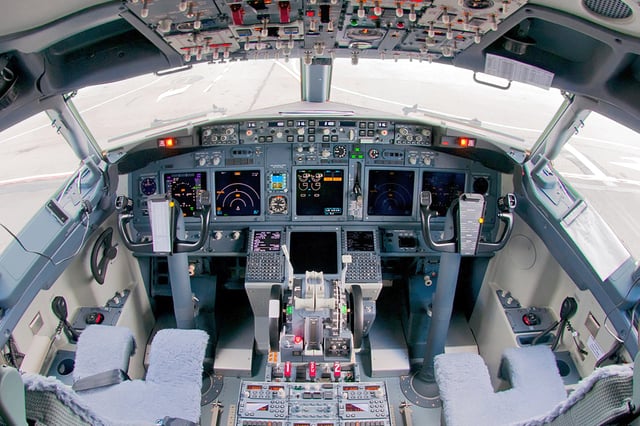
Next Generation 737-800 cockpit

Classic 737-300 cockpit
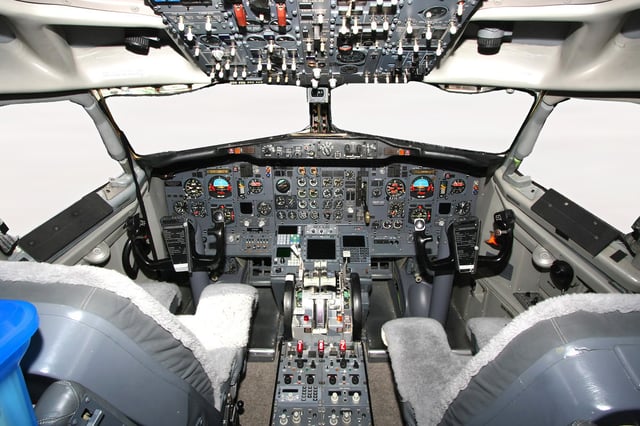
Original 737-200 cockpit
The primary flight controls are intrinsically safe. In the event of total hydraulic system failure or double engine failure, they will automatically and seamlessly revert to control via servo tab. In this mode, the servo tabs aerodynamically control the elevators and ailerons; these servo tabs are in turn controlled by cables running to the control yoke. The pilot's muscle forces alone control the tabs. For the 737 Next Generation, a six-screen LCD glass cockpit with modern avionics was implemented while retaining crew commonality with previous generation 737.[81]
Most 737 cockpits were delivered with "eyebrow windows" positioned above the main glareshield, which were a feature of the original 707 and 727[82] to allow for better crew visibility.[83] Contrary to popular belief, these windows were not intended for celestial navigation[84] (only the military T-43A had a sextant port for star navigation, which the civilian models lacked[85]). With modern avionics, the windows became redundant, and many pilots actually placed newspapers or other objects in them to block out sun glare. They were eliminated from the 737 cockpit design in 2004, although they are still installed on customer request.[86] The eyebrow windows are sometimes removed and plugged, usually during maintenance overhauls, and can be distinguished by the metal plug which differs from the smooth metal in later aircraft that were not originally fitted with the windows.[86]
Upgrade packages
Winglets
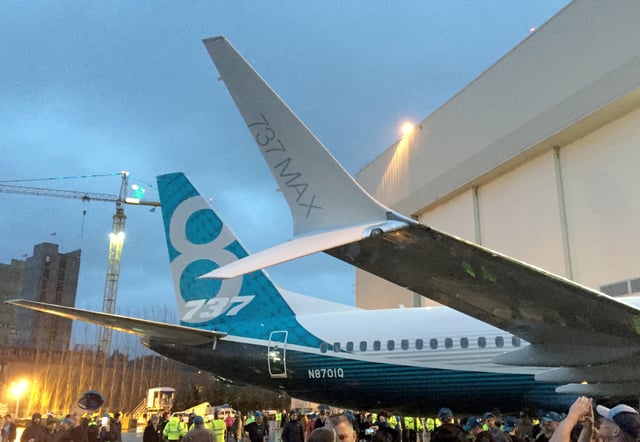
737 MAX Advanced Technology Winglet
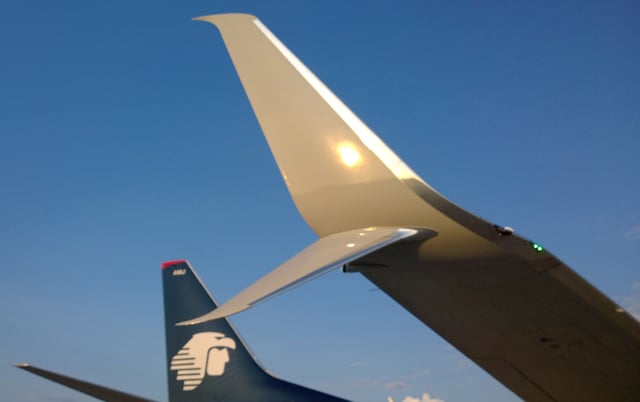
737 Split Scimitar Winglet on an Aeromexico Next Generation 737
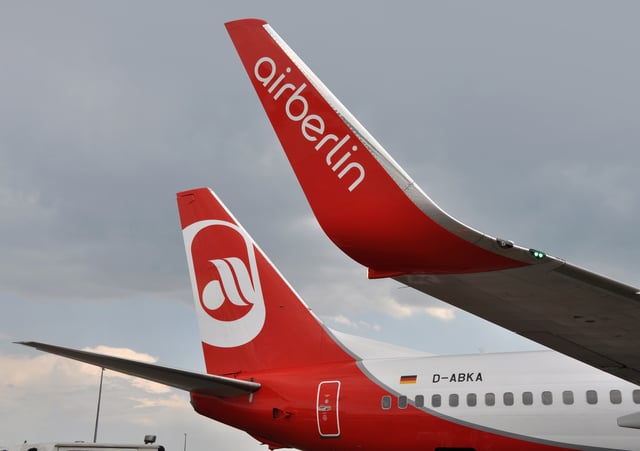
737 Blended Winglet on an Air Berlin Next Generation 737
Blended winglets are in production on 737 NG aircraft and are available for retrofit on 737 Classic models. These winglets stand approximately 8 feet (2.4 m) tall and are installed at the wing tips. They help to reduce fuel burn (by reducing vortex drag), engine wear, and takeoff noise. Overall fuel efficiency improvement is up to five percent through the reduction of lift-induced drag.[87][88]
Split Scimitar winglets became available in 2014 for the 737-800, 737-900ER, BBJ2 and BBJ3, and in 2015 for the 737-700, 737-900 and BBJ1.[89] Split Scimitar winglets were developed by Aviation Partners Inc. (API), the same Seattle based corporation that developed the blended winglets; the Split Scimitar winglets produce up to a 5.5% fuel savings per aircraft compared to 3.3% savings for the blended winglets. Southwest Airlines flew their first flight of a 737-800 with Split Scimitar winglets on April 14, 2014.[90] The next generation 737, 737 MAX, will feature an Advanced Technology (AT) Winglet that is produced by Boeing. The Boeing AT Winglet resembles a cross between the Blended Winglet and the Split Scimitar Winglet.[91]
Flight systems
Carbon brakes
As of July 2008 the 737 features carbon brakes manufactured by Messier-Bugatti. These new brakes, now certified by the Federal Aviation Administration, weigh 550–700 lb (250–320 kg) less than the steel brakes normally fitted to the Next-Gen 737s (weight savings depend on whether standard or high-capacity brakes are fitted).[92] A weight reduction of 700 pounds on a Boeing 737-800 results in 0.5% reduction in fuel burn.[93]
Short-field design package
A short-field design package is available for the 737-600, -700, and -800, allowing operators to fly increased payload to and from airports with runways under 5,000 feet (1,500 m). The package consists of sealed leading edge slats (improved lift), a two-position tail skid (enabling greater protection against tail strikes that may be caused by the lower landing speeds), and increased flight spoiler deflection on the ground. These improvements are standard on the 737-900ER.[94]
Interior
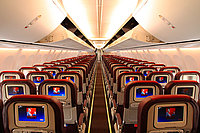
Boeing 737NG Sky Interior with pivot bins and LED lighting
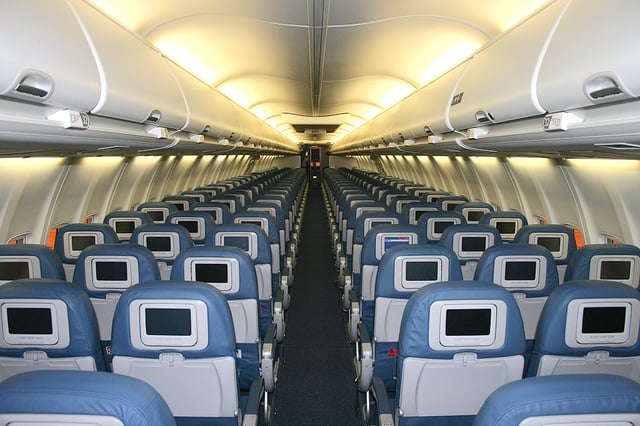
Boeing 737NG standard interior with curved panels
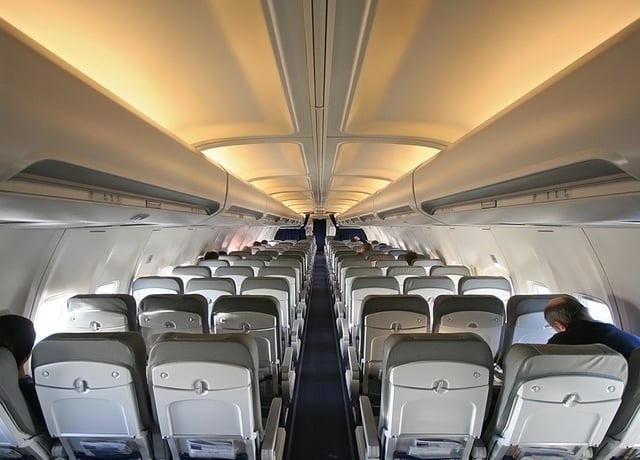
737 Classic interior in 3–3 economy class layout
The 737 interior arrangement has changed in successive generations. The original 737 interior was restyled for the 737 Classic models using 757 designs, while 777 architecture was used for the debut of the Next Generation 737. Designed using Boeing's new cabin concepts, the latest Sky Interior features sculpted sidewalls and redesigned window housings, along with increased headroom and LED mood lighting.[95][96] Larger pivot-bins similar to those on the 777 and 787 have more luggage space than prior designs.[96] The Sky Interior is also designed to improve cabin noise levels by 2–4 dB.[95] The first 737 equipped with the Boeing Sky Interior was delivered to Flydubai in late 2010.[95] Continental Airlines,[97][98]Alaska Airlines,[99] Malaysia Airlines,[100] and TUIFly have also received Sky Interior-equipped 737s.[101]
Variants

A comparison of the different 737 variants
The 737 models can be divided into four generations, including thirteen major variants. The "Original" models consist of the 737-100, 737-200/-200 Advanced. The "Classic" models consist of the 737-300, 737-400, and 737-500. The "Next Generation" variants consist of the 737-600, 737-700/-700ER, 737-800, and 737-900/-900ER. Of these variants, many feature additional versions such as the T-43, which was a modified Boeing 737-200 used by the United States Air Force (USAF). The fourth generation derivative "MAX" variants consist of the 737 MAX 7, 737 MAX 8, and 737 MAX 9 which will replace the -700, -800 and -900/900ER versions, respectively. The MAX 8 has a high-density version called the MAX 200. A fourth MAX variant, the 737 MAX 10 is currently under development and is the largest 737 to date.
737 Original series
737-100
The initial model was the 737-100, which was launched in February 1965. The -100 was rolled out on January 17, 1967, had its first flight on April 9, 1967, and entered service with Lufthansa in February 1968. The aircraft is the smallest variant of the 737. A total of 30 737-100s were ordered and delivered; the final commercial delivery took place on October 31, 1969 to Malaysia–Singapore Airlines. No 737-100s remain in commercial service. The original Boeing prototype, last operated by NASA and retired more than 30 years after its maiden flight, is on exhibit in the Museum of Flight in Seattle.[102]
737-200
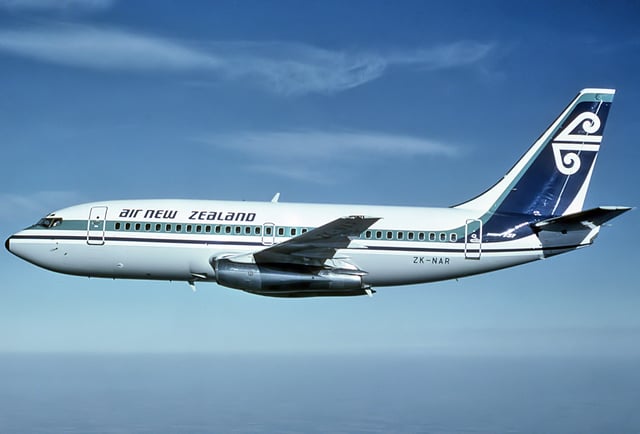
The 737-200 is 6 ft 2 in (1.88 m) longer than the -100
The 737-200 is a 737-100 with an extended fuselage, launched by an order from United Airlines in 1965. The -200 was rolled out on June 29, 1967, and entered service with United in April 1968. The 737-200 Advanced is an improved version of the -200, introduced into service by All Nippon Airways on May 20, 1971.[103] The -200 Advanced has improved aerodynamics, automatic wheel brakes, more powerful engines, more fuel capacity, and longer range than the -100.[104] Boeing also provided the 737-200C (Cargo), which allowed for conversion between passenger and cargo use and the 737-200QC (Quick Change), which facilitated a rapid conversion between roles. The 1,095th and last delivery of a -200 series aircraft was in August 1988 to Xiamen Airlines.[4][105]
With a gravel kit modification the 737-200 can use unimproved or unpaved landing strips, such as gravel runways, that other similarly-sized jet aircraft cannot. Gravel-kitted 737-200 Combis are currently used by Canadian North, First Air, Air Inuit, Nolinor and Air North in northern Canada. For many years, Alaska Airlines made use of gravel-kitted 737-200s to serve Alaska's many unimproved runways across the state.[106]
Nineteen 737-200s, designated T-43, were used to train aircraft navigators for the U.S. Air Force. Some were modified into CT-43s, which are used to transport passengers, and one was modified as the NT-43A Radar Test Bed. The first was delivered on July 31, 1973 and the last on July 19, 1974. The Indonesian Air Force ordered three modified 737-200s, designated Boeing 737-2x9 Surveiller. They were used as Maritime reconnaissance (MPA)/transport aircraft, fitted with SLAMMAR (Side-looking Multi-mission Airborne Radar). The aircraft were delivered between May 1982 and October 1983.[107]
Many 737-200s have been phased out or replaced by newer 737 versions. After 40 years, in March 2008, the final 737-200 aircraft in the U.S. flying scheduled passenger service were phased out, with the last flights of Aloha Airlines.[108] The variant still sees regular service through North American charter operators such as Sierra Pacific.[109]
In July 2018, there were a combined 58 Boeing 737-200s in service, mostly with "second and third tier" airlines, and those of developing nations.[109]
737 Classic series

737-300, the midsize 737 Classic
737 Next Generation

Delta Air Lines Boeing 737-800
By the early 1990s, it became clear that the new Airbus A320 was a serious threat to Boeing's market share, as Airbus won previously loyal 737 customers such as Lufthansa and United Airlines. In November 1993, Boeing's board of directors authorized the Next Generation program to replace the 737 Classic series. The -600, -700, -800, and -900 series were planned.[111] After engineering trade studies and discussions with major 737 customers, Boeing proceeded to launch the 737 Next Generation series in late 1993, with 6,996 built as of January 2019.[4] Variants include the P-8 Poseidon.
737 MAX
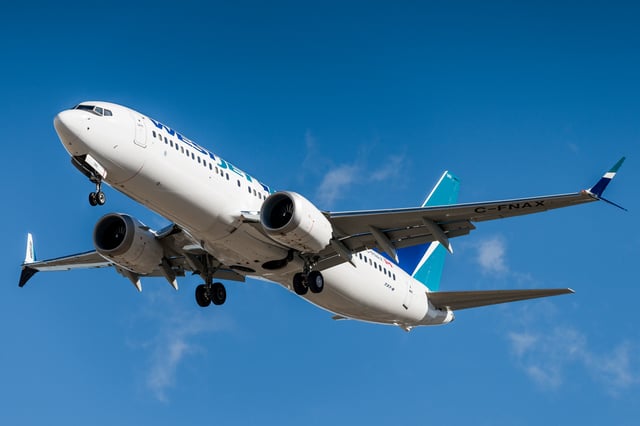
WestJet Boeing 737 MAX 8
The Boeing 737 MAX is the fourth generation of the 737, succeeding the Boeing 737 Next Generation (NG). After Airbus launched the Airbus A320neo family in December 2010, achieving 1,029 orders by June 2011 and breaking Boeing's monopoly with American Airlines with an order for 130 A320neos that July,[112] Boeing launched the 737 MAX program on August 30, 2011.[113] The first flight was on January 29, 2016.[114] It gained FAA certification on March 8, 2017.[115] The first delivery was a MAX 8 on May 6, 2017 to Malindo Air,[116] which put it into service on May 22, 2017.[117]
The 737 MAX is based on earlier 737 designs. It is re-engined with more efficient CFM International LEAP-1B powerplants, aerodynamic improvements (most notably split-tip winglets), and airframe modifications. The 737 MAX series is offered in four main variants, typically offering 138 to 230 seats and a range of 3,215 to 3,825 nmi (5,954 to 7,084 km). The 737 MAX 7, MAX 8 (including the denser, 200-seat MAX 200) , and MAX 9 replace, respectively, the 737-700, -800, and -900. The further stretched 737 MAX 10 has also been added to the series. As of January 2019, the 737 MAX has received 5,011 firm orders.[4]
In March 2019, the 737 MAX was grounded worldwide after two similar fatal crashes within a five–month period.[118]
Boeing Business Jet (BBJ)
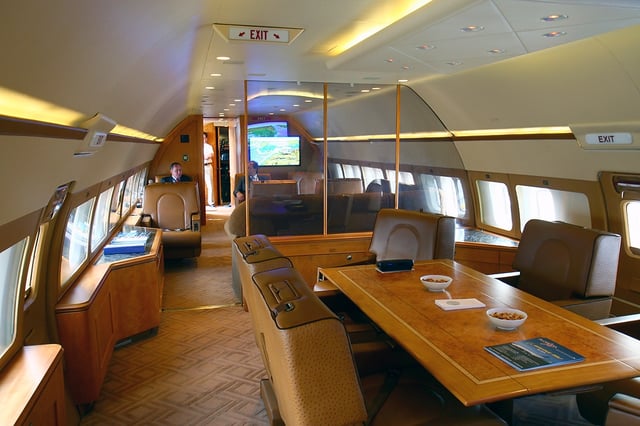
BBJ cabin
The Boeing Business Jet is a customized version of the 737. In the late 1980s, Boeing marketed the 77-33 jet, a business jet version of the 737-300.[119] The name was short-lived. After the introduction of the Next Generation series, Boeing introduced the Boeing Business Jet (BBJ) series. The BBJ1 was similar in dimensions to the 737-700 but had additional features, including stronger wings and landing gear from the 737-800, and had increased range over the other 737 models through the use of extra fuel tanks. The first BBJ rolled out on August 11, 1998 and flew for the first time on September 4.[120]
On October 11, 1999 Boeing launched the BBJ2. Based on the 737-800, it is 19 feet 2 inches (5.84 m) longer than the BBJ, with 25% more cabin space and twice the baggage space, but has slightly reduced range. It is also fitted with auxiliary belly fuel tanks and winglets. The first BBJ2 was delivered on February 28, 2001.[120]
Boeing's BBJ3 is based on the 737-900ER. The BBJ3 has 1,120 square feet (104 m2) of floor space, 35% more interior space, and 89% more luggage space than the BBJ2. It has an auxiliary fuel system, giving it a range of up to 4,725 nautical miles (8,751 km), and a Head-up display. Boeing completed the first example in August 2008. This aircraft's cabin is pressurized to a simulated 6,500-foot (2,000 m) altitude.[121][122]
Freighter
Boeing has signed an agreement with Chinese YTO Airlines to provide the airline with 737-800 Boeing Converted Freighters (BCFs) pending a planned program launch.[123] In 2016, Boeing officially launched the 737-800BCF program, converting old passenger jets to dedicated freighters.[124] The first aircraft was delivered in 2018 to GECAS, which is leased to West Atlantic.[125]
Operators
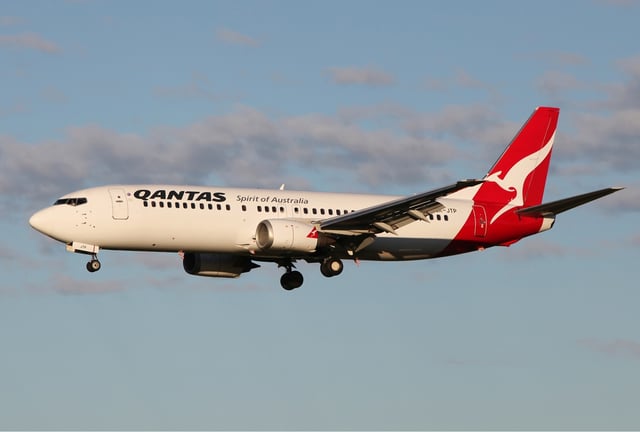
Qantas (Jetconnect) Boeing 737-400 landing at Melbourne Airport
In March 2018, the 10,000th 737 was rolled out as over 4,600 orders are pending.[9] The 737 is operated by more than 500 airlines, flying to 1,200 destinations in 190 countries: over 4,500 are in service and at any given time there are on average 1,250 airborne worldwide. On average, somewhere in the world, a 737 took off or landed every five seconds in 2006.[11] Since entering service in 1968, the 737 has carried over 12 billion passengers over 74 billion miles (120 billion km; 65 billion nm), and has accumulated more than 296 million hours in the air. The 737 represents more than 25% of the worldwide fleet of large commercial jet airliners.[11][126]
Civilian
As of July 2018, 58 Boeing 737-200 aircraft were in civilian service.[109]
Military
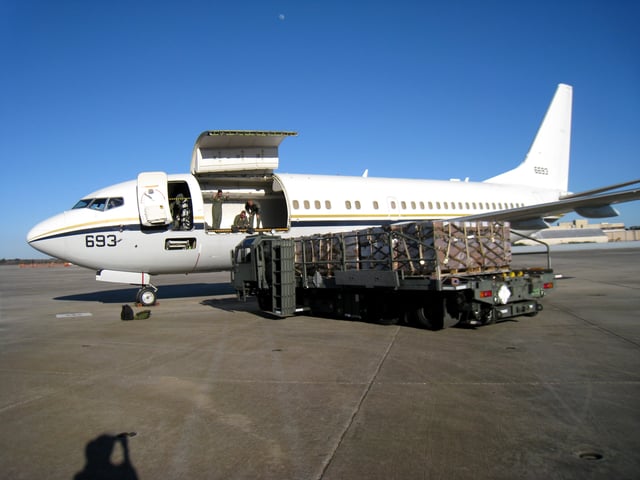
A United States Navy C-40A, a variant of the 737-700C
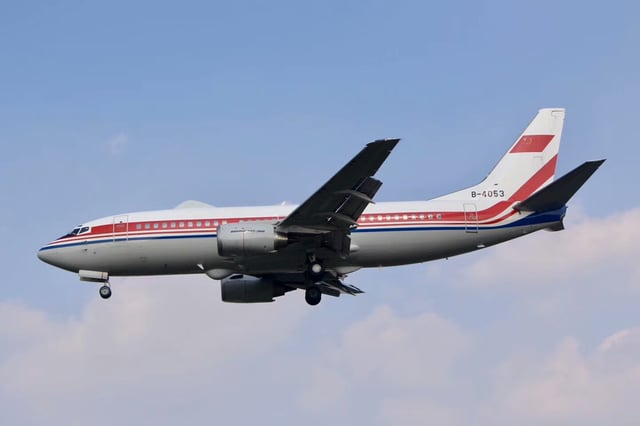
A PLAAF 737 electronic signals intelligence (ELINT) version
Many countries operate the 737 passenger, BBJ, and cargo variants in government or military applications.[127] Users with 737s include:
Argentina
Australia
Brazil
Chile
Colombia
India
Indonesia
Iran
Mongolia
Pakistan
Peru
Taiwan (Republic of China)
Thailand
Turkey
Competition
The Boeing 737 Classics and the Boeing 737 Next Generation have faced main challenges from the Airbus A320 family introduced in 1988, which was developed to compete also with the McDonnell Douglas MD-80/90 series and the Boeing 717 (formerly named McDonnell Douglas MD-95).
Boeing has delivered over 10,478 aircraft of the 737 family since late 1967,[4] with over 8,900 of those deliveries since March 1, 1988,[128] and has a further 4,754 on firm order as of January 2019.[4] In comparison, Airbus has delivered 8,638 A320 series aircraft since their certification/first delivery in early 1988, with another 6,023 on firm order (as of January 2019).[129]
Orders and deliveries
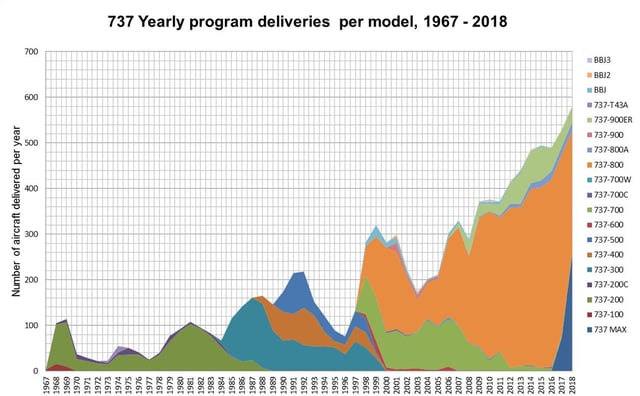
737 deliveries per year, 1967-2018
Boeing delivered the 5,000th 737 to Southwest Airlines on February 13, 2006, the 6,000th 737 to Norwegian Air Shuttle in April 2009, the 8,000th 737 to United Airlines on April 16, 2014.[130] The 10,000th 737 was ordered in July 2012.[131]
Total production
In total, 10,559 Boeing 737 aircraft have been delivered as of August 31, 2019.[4]
| Total Orders | Total Deliveries | Unfilled | 2019 | 2018 | 2017 | 2016 | 2015 | 2014 | 2013 | 2012 | 2011 | 2010 | 2009 | 2008 | 2007 |
|---|---|---|---|---|---|---|---|---|---|---|---|---|---|---|---|
| 15,155 | 10,560 | 4,595 | 116 | 580 | 529 | 490 | 495 | 485 | 440 | 415 | 372 | 376 | 372 | 290 | 330 |
| Year | 2006 | 2005 | 2004 | 2003 | 2002 | 2001 | 2000 | 1999 | 1998 | 1997 | 1996 | 1995 | 1994 | 1993 | 1992 | 1991 | 1990 | 1989 | 1988 | 1987 |
|---|---|---|---|---|---|---|---|---|---|---|---|---|---|---|---|---|---|---|---|---|
| Deliveries | 302 | 212 | 202 | 173 | 223 | 299 | 282 | 320 | 282 | 135 | 76 | 89 | 121 | 152 | 218 | 215 | 174 | 146 | 165 | 161 |
| Year | 1986 | 1985 | 1984 | 1983 | 1982 | 1981 | 1980 | 1979 | 1978 | 1977 | 1976 | 1975 | 1974 | 1973 | 1972 | 1971 | 1970 | 1969 | 1968 | 1967 |
|---|---|---|---|---|---|---|---|---|---|---|---|---|---|---|---|---|---|---|---|---|
| Deliveries | 141 | 115 | 67 | 82 | 95 | 108 | 92 | 77 | 40 | 25 | 41 | 51 | 55 | 23 | 22 | 29 | 37 | 114 | 105 | 4 |
Units by generation
As of August 2019, 15,155 units of the Boeing 737 have been ordered, with 4,595 units to be delivered.[4] Units built by model type for 737 Original, Classic, Next Generation, and Boeing Business Jet families are as follows:
| Generation | Model series | ICAO code[139] | Orders | Deliveries | Unfilled orders | First flight |
|---|---|---|---|---|---|---|
| 737 Original | 737-100 | B731 | 30 | 30 | — | April 9, 1967 |
| 737-200 | B732 | 991 | 991 | — | August 8, 1967 | |
| 737-200C | 104 | 104 | — | September 18, 1968 | ||
| 737-T43A | 19 | 19 | — | March 10, 1973 | ||
| 737 Classic | 737-300 | B733 | 1,113 | 1,113 | — | February 24, 1984 |
| 737-400 | B734 | 486 | 486 | — | February 19, 1988 | |
| 737-500 | B735 | 389 | 389 | — | June 30, 1989 | |
| 737 Next Generation | 737-600 | B736 | 69 | 69 | — | January 22, 1998 |
| 737-700 | B737 | 1,128 | 1,128 | — | February 9, 1997 | |
| 737-700C | 22 | 22 | — | April 14, 2000[140] | ||
| 737-700W | 14 | 14 | — | May 20, 2004[141] | ||
| 737-800 | B738 | 4,991 | 4,982 | 9 | July 31, 1997 | |
| 737-800A | 157 | 120 | 37 | April 25, 2009[142] | ||
| 737-900 | B739 | 52 | 52 | — | August 3, 2000 | |
| 737-900ER | 505 | 505 | — | September 1, 2006 | ||
| 737 Boeing Business Jet | 737-BBJ1 (-700) | B737 | 124 | 121 | 3 | September 4, 1998 |
| 737-BBJ2 (-800) | B738 | 23 | 21 | 2 | N/A | |
| 737-BBJ3 (-900) | B739 | 7 | 7 | — | N/A | |
| 737 MAX | 737 MAX (-7,-8,-9,-10) | B37M / B38M / B39M / | 4,931 | 387 | 4,544 | January 29, 2016[143] |
Orders and deliveries data from Boeing through August 31, 2019[4]
Accidents and incidents
An analysis by Boeing on commercial jet airplane accidents in the period 1959–2013 showed that the original series had a hull loss rate of 1.75 per million departures versus 0.54 for the classic series and 0.27 for the Next Generation series.[147]
Aircraft on display
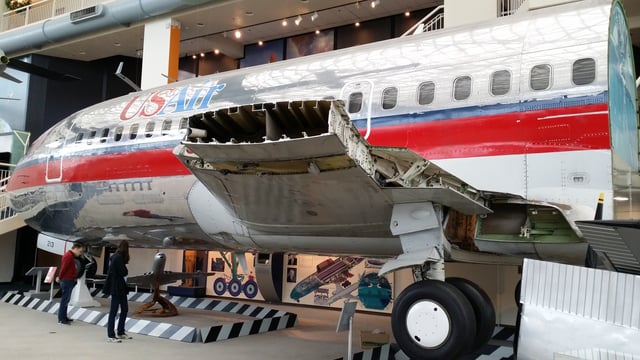
US Airways 737-200 fuselage section at the Museum of Flight
Owing to the 737's long production history and popularity, many older 737s have found use in museums after reaching the end of useful service.
19437/1: 737-130 registered N515NA on static display at the Museum of Flight in Seattle, Washington. It was the first 737 built and is painted in NASA markings.[148]
19047/14: 737-222 registered N9009U preserved by Southern Illinois University Carbondale at Southern Illinois Airport.[149]
20213/160: 737-201 registered N213US forward fuselage on static display at the Museum of Flight in Seattle, Washington in USAir livery.[150]
20561/292: 737-281 registered LV-WTX on static display at the National Museum of Aeronautics in Morón, Buenos Aires.[151]
20562/293: 737-281 registered CC-CSK fuselage preserved at Motel Bahía in Concón, Chile.[152][153]
21262/470: 737-2H4 registered C-GWJT on static display at the British Columbia Institute of Technology Aerospace Technology Campus in Richmond, British Columbia. It is used for ground instructional training. The aircraft was donated by WestJet and bears its livery.[154][155]
21340/499: 737-2H4 registered N29SW on static display at the Kansas Aviation Museum in Wichita, Kansas. It was formerly operated by Ryan International Airlines and prior to that Southwest Airlines.[156][157]
21712/557: 737-275 registered C-GIPW preserved in operational condition at Alberta Flying Heritage Museum in Villeneuve, Alberta. Painted in Pacific Western Airlines livery.[158]
22578/767: 737-290C registered N740AS on static display at the Alaska Aviation Heritage Museum in Anchorage, Alaska. It was formerly operated by Alaska Airlines.[159]
22826/878: 737-2H4 registered YV1361 preserved at a hotel in Santiago, Chile. It was formerly operated by Avior Airlines.[160]
23059/980: 737-2Z6 registered 22-222 on static display at the Royal Thai Air Force Museum in Bangkok.[161][162]
22940/1037: 737-3H4 registered N300SW on static display at the Frontiers of Flight Museum in Dallas, Texas. It was the first such aircraft delivered to Southwest Airlines in November 1984.[163]
23257/1124: 737-301 registered PK-AWU on static display at ITE College Central in Singapore.[164]
23472/1194: 737-219 registered ZS-SMD on static display at the South African Airways Museum in Germiston, Gauteng.[165]
23660/1294: 737-377 registered G-CELS on static display at Norwich Airport (UK) as an Aviation Academy trainer. It is painted in the silver & red Jet2.com colour scheme, without the logo branding.[166]
27286/2528: 737-3Q8 registered N759BA on static display at the Pima Air & Space Museum in Tucson, Arizona. It is painted in China Southern Airlines markings, and was previously operated by the airline as B-2921.[167]
Specifications
| Variant | 737-100 | 737-200 | 737-300/-400/-500 | 737-600/-700/-800/-900 | 737 MAX-7/8/9/10[169][170] | |
|---|---|---|---|---|---|---|
| Cockpit crew | Two | |||||
| 2-class seats | 85 : 12F 73Y | 102 : 14F@38" 88Y@34" | 126/147/110 | 108/128/160/177 | 138/162/178/188 | |
| 1-class seats | 103@34" - 118@30" | 115@34" - 130@30" | 140+/159-168/122-132 | 123-130/140+/175+/177-215 | 153/178/193/204 | |
| Exit limit | 124 | 136 | 149/188/145 | 149/149/189/220 | 172/210/220/230 | |
| Length | 94 ft (29 m) | 100 ft 2 in (30.53 m) | 102–120 ft (31–37 m) | 102–138 ft (31–42 m) | 116.7–143.7 ft (35.56–43.8 m) | |
| Span | 93 ft (28 m) | 94 ft 9 in (28.88 m) | 112 ft 7 in (34.32 m) winglets: 117 ft 5 in (35.79 m) | 117 ft 10 in (35.92 m) | ||
| Wing[171] | 979.9 sq ft (91.04 m2), 25° sweep | 1,341.2 sq ft (124.60 m2) | 1,370 sq ft (127 m2)[172] | |||
| Height | 37 ft (11 m) | 36 ft 6 in (11.13 m) | 41 ft (12 m) | 40 ft 4 in (12.29 m) | ||
| Width | Fuselage: 148 inches (3.8 m), Cabin: 139.2 inches (3.54 m) | |||||
| Cargo | 650 cu ft (18 m3) | 875 cu ft (24.8 m3) | 882–1,373 cu ft 25.0–38.9 m3 | 720–1,826 cu ft 20.4–51.7 m3 | 1,543–1,814 cu ft 43.7–51.4 m3 | |
| MTOW | 110,000 lb (50,000 kg) | 128,100 lb (58,100 kg) | 133,500–150,000 lb 60,600–68,000 kg | 144,500–187,700 lb 65,500–85,100 kg | 177,000–194,700 lb 80,300–88,300 kg | |
| OEW | 62,000 lb (28,000 kg) | 65,300 lb (29,600 kg) | 70,440–76,760 lb 31,950–34,820 kg | 80,200–98,495 lb 36,378–44,677 kg | MAX 8: 99,360 lb 45,070 kg[173] | |
| Fuel capacity | 4,720US gal / 17,865L | 5,970US gal / 22,596L[1] | 5,311USgal 20,100L | 6,875-7,837 US gal 26,022-29,666 L | 6,853 US gal 25,941 L | |
| Speed | Mach 0.745–Mach 0.82 (430–473 kn; 796–876 km/h) Cruise—MMO[172] | Mach 0.785 (453 kn; 838 km/h) Cruise | ||||
| Takeoff[2] | 6,099 ft (1,859 m)[171] | 7,500–8,690 ft 2,290–2,650 m[174] | 6,161–7,598 ft 1,878–2,316 m[171] | |||
| Range | 1,540 nmi (2,850 km)[175] | 2,600 nmi (4,800 km)[3][176] | 2,060–2,375 nmi 3,815–4,398 km[174] | 2,935–3,010 nmi 5,436–5,575 km[177] | 3,300–3,850 nmi 6,110–7,130 km | |
| Ceiling[172] | 37,000 ft (11,300 m) | 41,000 ft (12,500 m) | ||||
| Engines (×2) | Pratt & Whitney JT8D-7/-9/-5/-17 | CFM56-3 series | CFM56-7 series | CFM LEAP-1B | ||
| Thrust (×2) | 14,000 lbf (62 kN)[175] | 14,500–16,400 lbf 64–73 kN[176] | 20,000–23,500 lbf 89–105 kN | 20,000–27,000 lbf 89–120 kN | up to 29,300 lbf (130 kN) | |
See also
Boeing 737 rudder issues
Related development
Boeing 737 AEW&C
Boeing 737 MAX
Boeing 737 Next Generation
Boeing Business Jet
Boeing C-40 Clipper
Boeing P-8 Poseidon
Boeing T-43
Aircraft of comparable role, configuration and era
Airbus A220
Boeing 717
Comac C919
Dassault Mercure
Embraer 195
Irkut MC-21
McDonnell Douglas DC-9
McDonnell Douglas MD-80
McDonnell Douglas MD-90
Sukhoi Superjet 100
Tupolev Tu-154M
Yakovlev Yak-42D